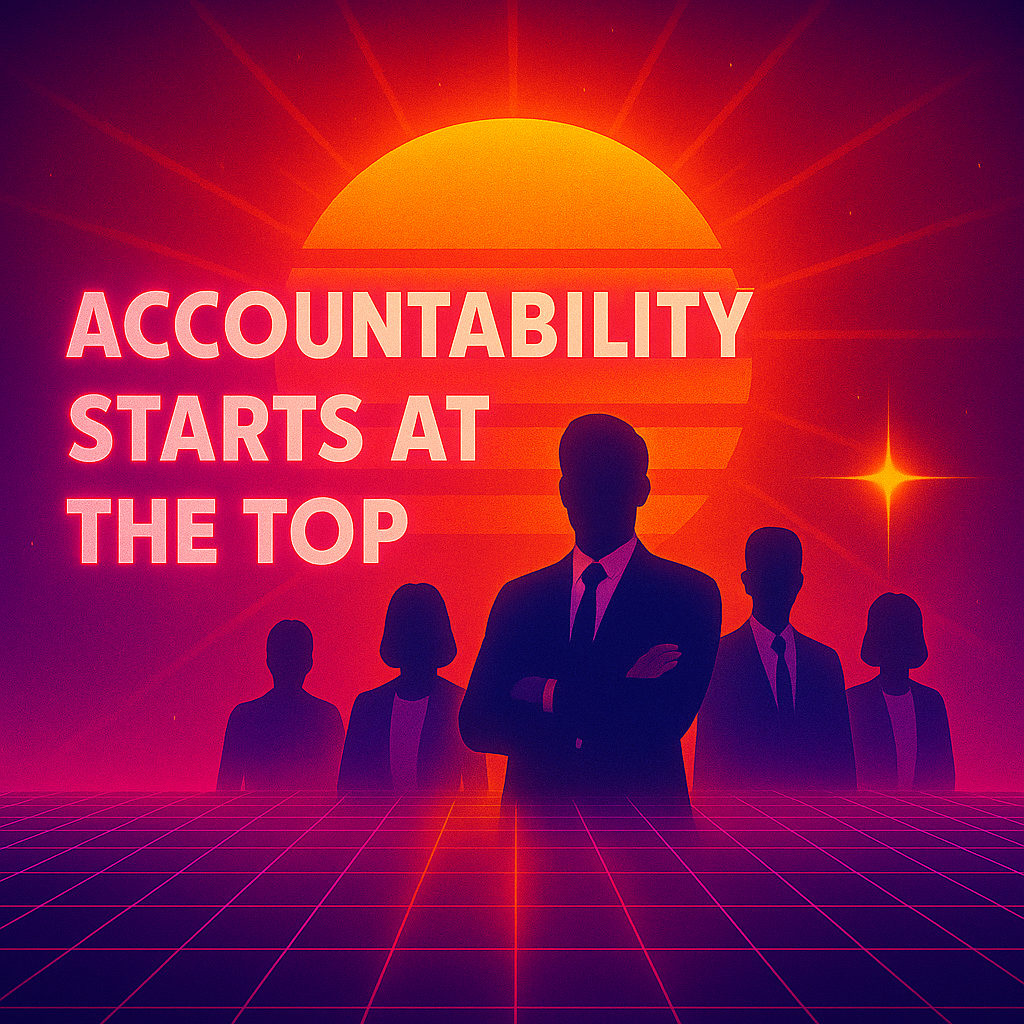Accountability Starts at the Top

Digital transformation is often treated like a technical project: buy a tool, hire a vendor, stand up a team, then hope culture, process, and outcomes fall into place.
Here’s the truth: no digital transformation succeeds without leadership accountability. When leaders own outcomes, everything else aligns...
...but when they don’t, failure is waiting in the wings.
Why Leadership Accountability Is Non-Negotiable
In our last series, we sas similar patterns over and over again. Projects become stalled. Our teams spin in circles. These new tools get under-utilized.
Gartner research emphasizes that successful transformations identify who is accountable for each objective. Without that clarity, responsibility diffuses and projects lose direction (Gartner, 2021).
Research on digital governance underscores the same point. Hanisch et al. (2023) argue that governance frameworks only work when decision rights and responsibilities are clearly assigned; otherwise, accountability is a façade.
And it’s not just about structure. Leadership also sets the tone for culture. Employees expect leaders to reflect fairness, values, and purpose, not just to manage change. MIT Sloan Management Review highlights that effective leadership in transformation means being visible, consistent, and purpose-driven (MIT Sloan Management Review, 2023).
What Happens Without Ownership
When accountability isn’t anchored in leadership, the cracks will show quickly:
- Milestones drift because no one owns the timeline or cross-team integration.
- Business and IT become misaligned as IT may deliver what was spec’d, but the business doesn’t adopt or benefit.
- Vendors begin to steer the roadmap when leaders avoid tough decisions.
- KPIs become outputs, instead of business outcomes that accelerate growth.
GE learned this lesson in its Predix platform rollout. By embedding shared accountability between the digital unit and traditional divisions, GE avoided silos and celebrated wins across the enterprise when efficiency and uptime improved (DigitalDefynd, 2023).
What Accountable Leadership Really Looks Like
Accountability doesn’t mean micromanaging. It means owning results.
Leaders can demonstrate this by:
- Clear, measurable commitments
Define outcomes the business cares about: revenue, cost, or risk. “Improve customer experience” is meaningless without a metric like “reduce support calls by 25% in 12 months.”- Be clear and concise!
- Visible sponsorship and decision ownership
Sponsorship at kickoff is easy. Accountability means staying engaged through delays and trade-offs, making the tough calls instead of deferring to vendors. - Governance and transparency
Accountability thrives in a governance model where reporting is regular, transparent, and tied to outcomes. Frameworks like COBIT lay out structures for decision rights and accountability in digital initiatives (ISACA, 2019). - Leadership that walks the talk
Research shows transformational leaders who model consistency and authenticity drive higher engagement and performance (Ahmad et al., 2023). Accountability isn’t rhetoric; it’s behavior.- An extremely important skill!
How to Embed Accountability: A Practical Plan
Here’s a month-long roadmap to put leadership accountability into action:
Week 1
Action: Identify 2-3 initiatives in progress or planned. For each, clarify who is accountable, responsible. Use a RACI chart.
Purpose: Ownership becomes visible from the very start.
Week 2
Action: Tie each initiative to outcomes in revenue, cost, or risk. Make the metrics visible.
Purpose: Shifts focus from activity to impact.
Week 3
Action: Set up leadership check-ins. Not just updates, but outcome reviews. Ask the question: Are we hitting the metrics? What are the blockers or barriers that exist?
Purpose: Creates visibility and discipline at all levels.
Week 4
Action: Leaders adjust scope, kill initiatives, or redirect the resources as needed. Celebrate outcome-aligned wins.
Purpose: Proves accountability is real.
Brutal Truths Leaders Need to Hear
- If you can’t say who will answer for a failed objective, you don’t own it.
- If your leadership team treats transformation as “IT’s problem,” you’ve already lost.
- Your IT team is ready and willing to be a partner with YOU!
- If your dashboards track tool rollouts instead of business value, you’re measuring the wrong things.
Accountability Activates Everything Else
When leaders truly own the outcomes:
- Governance becomes a habit, not busy work.
- Data integrity becomes everyone’s job.
- Technology choices align with strategy, not feature list or vendor roadmap.
- Culture shifts from resistance to ownership.
Final Word
The first step to real results isn’t buying more. It’s leaders standing up and saying:
“This transformation is on me. I’ll measure it. I’ll be visible. I’ll answer for it.”
That’s the line between digital theater and transformation that sticks.
Remember that?
Next in the Series: Governance Without Bureaucracy.
Let's get real on how we turn governance from red tape into the discipline that accelerates digital transformation.
Real talk. Real strategy. Real results in digital transformation.
References
Ahmad, M., Bashir, H., & Raziq, M. M. (2023). Fostering accountability through digital transformation: Leadership’s role in enhancing techno-work engagement in the public sector. ResearchGate. https://www.researchgate.net/publication/386224261
DigitalDefynd. (2023). Examples of successful digital transformation in businesses. DigitalDefynd Education. https://digitaldefynd.com/IQ/examples-of-successful-digital-transformation-in-businesses
Gartner. (2021). Who should take responsibility for digital transformation in government. Gartner. https://www.gartner.com/en/articles/who-s-really-accountable-for-digital-transformation-in-government
Hanisch, C., Lindeque, J., & Sütterlin, S. (2023). Digital governance: A conceptual framework. Journal of Business Research, 160, 113765. https://doi.org/10.1016/j.jbusres.2023.113765
ISACA. (2019). COBIT 2019 framework: Governance and management objectives. ISACA. https://www.isaca.org/resources/cobit
MIT Sloan Management Review. (2023). Leadership’s digital transformation: Leading purposefully in an era of context collapse. https://sloanreview.mit.edu/projects/leaderships-digital-transformation